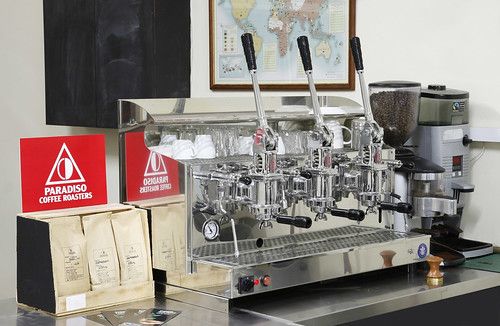I really like lever group espresso machines, but some are better than others.
I'm referring to commercial machines though, the ones with the big spring inside, not the E61 group with a lever as fitted to many high end domestic machines and commercial machines which utilises a pump - a very good group but different design.
We have a customer with an Astoria Rapallo and you are correct, this is a very hot group. I found it difficult to set up with some coffees because of the high temperature - quite challenging.
I also serviced a fantastic Faema "Zodiaco" from the 1950's not so long ago. A fantastic machine that has been producing cracking espresso for many years.
We also have had customers with Fiorenzato, Visacrem, Gaggia, San Marco, Futurmat, Izzo and Rancilio's lever machines - my favourite, the Fiorenzato. Exceptional coffee from this machine and so reliable.
Many lever machines have the group bolted directly onto the boiler - often very hot as the main boiler is often around 116-118 degrees Celsius when run at around 1 bar of pressure, others use a thermal reserve.
There have been attempts made to cool the water on route to the group with various valves and pipework by different manufacturers but on the whole they remain pretty similar in design.
Lever group machines are quite different to a "standard" modern machine and make coffee in quite a different way. If you ever have the opportunity to set one up alongside a regular machine you will quickly see that the grinder has to be adjusted quite differently.
When pulling the lever down, a cam of various types will lift a piston inside the group and at the same time, compress a large and powerful spring. When the piston rises past a certain point it uncovers a hole through which water enters from the boiler or thermal reserve depending on design. The water, cooled slightly by its travels and usually under about 1 bar pressure (max hopefully) floods through into the cylinder/chamber above the coffee. Under this low pressure, the water infuses the coffee grounds held in the filter holder and begins to drip into the cup. At this point the lever is released and the spring takes over, forcing the water down through the coffee for a full extraction. Most machines have a chamber about the size of a small or normal shot of espresso when the piston is at its highest so two pulls of the lever will often be required for a double espresso - how long you wait before releasing the lever needs to be practiced to get uniform shots.
The spring that provides pressure during this process is somewhat different to the normal 9 bar pump fed modern group. When the piston is at its highest and the spring compressed the most it provides the highest pressure when released. The spring relaxes when the piston lowers and so the pressure drops. The infusion process and high initial pressure help to emphasise the first and often quite acidic part of the espresso shot and of course the lower pressure towards the end help to suppress the tendency of shots to become bitter.
It doesn't work for all coffees but the results can be very good.
Manufacturers have tried to replicate this action in the modern pumped group. Latest tech using PID systems, electronics, pressure profiling etc are all there to improve the shot and make it more consistent. Many ideas have come from considering the "old" lever group! Some E61 groups have a spring loaded piston that compresses when the group first runs - a kind of mechanical buffer to absorb the initial 9 bar pressure resulting in a pause before the shot runs and give a degree of pre-infusion. Others have experimented with chambers on the group which contain air - this air compresses under pressure giving a similar effect.
The bottom line is that we are starting to realise that the designers of many of the lever groups put a lot of effort into their design... Kinda makes you wonder why we bother with twin boiler machines and PID?
They are reliable... give excellent shots when matched to a coffee that suits... they dose out regular shots... look great... Easy to service (watch out for that spring)... What's not to like?
I'm a big fan of the latest tech too but these old designs are pretty cool and can surprise.

